- page 1 -
(The Study of Threes)
http://threesology.org
Before beginning to present some "threes" in religion, let me impress upon the reader that our present day usage of the word "Trinity" is not a word used in ancient times, though past cultures may have had some equivalent. It is also necessary to point out that ancient peoples did not consciously create three-patterned groupings into what we refer to as triads, Trinities, trimurti, etc... This perception may in fact be a modern construct imposed on information collected from the past, but that no culture in the past may have done so with the same deliberation. In other words, they may not have even had a "trinity" or "triad" concept. This is an important point in order to distinguish a difference in thinking due to a difference in perception that may well suggest a difference in brain structure, even if a modern day brain scan would have revealed what appears to be the same so-called "normal" brain. While their brain may have looked the same, it may have functioned quite differently, and I am not talking about knowledge or experiences, but of an actual maturational difference.
| Late 19th and early 20th century Anthropologists searched for the
historical origins of religion and tended towards a tripartite,
quasi-evolutionary progression from: |
3 great Monotheistic religions: Islamic ~ Judaic ~ Christian
3 different ways of spelling an ancient Egyptian diety:
- Amon (â´men, ä´-)
- Ammon (à´men)
- Amen (ä´mèn)
Originally the chief god of Thebes, Amon grew increasingly important in Egypt, and eventually, as Amon Ra (Ra = Solar god), he was identified with RA as the supreme deity. He was also identified with the Greek ZEUS (the Roman JUPITER... 'Zues-Pater'... 'Zeus our father'). (Jesus = JeZeus)
Note: the present-day usage of the word "amen" to signify the closing of a prayer is yet another representative clue that modern religions have historical connections to ancient solar worship. We could also include the three-letter meditation (chant) word AUM (Om) as a derivative of the A...u- men Ra reference.
Amen-Ra was one third of the Great Triad of Waset along with Mut and Khensu who were the other two thirds.
Amen-Ra was a dual deity devised to merge the worship of Amen with the older solar cult of Ra. By combining the two, the deities are said to dwell within one another.
3 physical "points" to the devil: 1 = tail 2 = horns 3 = canines 3 to 1 ratio of points to the devil: 3 prongs to 1 pitchfork. 3 physical distinctions of a satyr in Greek mythology:
3 "H"-related attributes of the devil:
|
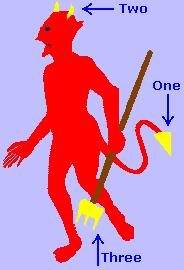 --- Index of Image Archive --- |
 Om, in Hinduism and other religions chiefly of India, a sacred syllable that is considered to be the greatest of all the mantras, or sacred formulas. The symbol Om is composed of the three sounds A-U-M (in Sanskrit, the vowels A and U coalesce to become O), which are said to represent several important triads: 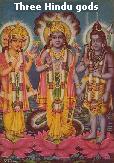 3 major Hindu gods: Brahma~ Vishnu~
Siva
3 major Hindu gods: Brahma~ Vishnu~
Siva3 sacred vedic scriptures: Rg~ Yajur~ Sama 3 powers: Action~ Knowledge~ Will 3 time periods: Dawn~ Noonday~ Dusk 3 manifested states: Gross~ Shapeless~ Subtle 3 elements: Fire (agni)~ Sun (aditya)~ Wind (vayu) 3 states of being: A. Wakefulness (jagaritsa-sthanta, corresponding to Vaishvanara). B. Dream (svapna-sthana, corresponding to Taijasa). C. Deep Sleep (sushupta-sthana, corresponding to Prajna). 3 worlds: Earth (Bhu)~ Heaven (Svar)~ Atmosphere (Bhuvas) 3 modalities or guna: Expansive (rajas)~ Cohesive or Ascendant (sattva)~ Destructive or Descendant (tamas) etc... thus: Om mystically embodies the essence of the entire universe. |
|
Om is uttered at the beginning and end of Hindu Prayers~ Chants~ Meditations, and is freely used in Buddhist and Jaina ritual also. From the 6th century, the written symbol designating the sound is used to mark the beginning of a text in a manuscript or an inscription. The syllable is discussed in a number of the upanishads, which are the texts of philosophical speculation, and it forms the entire subject matter of one, the Mandukya. It is used in the practice of yoga and is related to techniques of auditory meditation. In the puranas the syllable is put to sectarian use; thus the saiva mark the lingam, or sign of Siva, with the symbol for Om, whereas the vaishnava identify the three sounds as referring to a trinity composed of Vishnu, his wife Sri, and the Worshipper. | |
OM is linguistically represented in such words as omnipresent, omnipotent, omniscient, Amen (ahh-m--en), omnivorous, omnibus, omega (as in Alpha and Omega) etc., and perhaps even ominous, omelet, and the 17th & 18th century European card game called ombré.
We might even want to include the three "OMG's":
- OMG (Oh My God)
- OMG (Oh My Goodness)
- OMG (Oh My Gracious)
If we view the "3" symbol of Om as symbolically representative of an environmental circumstance which:
- Was impressed upon the brow (physiology/genetics?) of humanity over centuries of exposure to it.
- That many people face East (rising Sun?) while in prayer.
- That mental symbols are mere metaphorical caricatures of such impressions... then the following image may be illustrative:
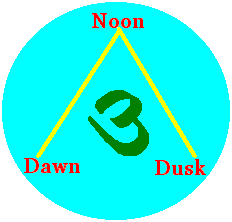
...the above image reflects 3 "moments" in 1 Sun, which may have been the single most influential impression that encouraged humanity into developing a symbolic representation of early solar worship by adopting the idea of 3 "persons" in one God. Clearly, the Sun had been viewed as a God by early peoples and that this notion of solar worship is still practiced in Islamic traditions by an insistence of followers of praying towards the East, where the Sun rises.
A question that needs to be asked at this point is whether the significance of the "Three" idea expressed in the Celtic traditions is: (1) Due to a Hindu influence. (2) Due to an as yet undiscovered non-Hindu influence. (3) Is an original conception based upon an evolving consciousness. or... the Celtic ideas influenced the Hindu (and other) "3"-focused traditions. |
It is important to observe that in the Middle Ages there was a Christian equivalent which was commonly used as a symbol of the "WORD." This was the Siglum which was quite wrongly compared with the words 'Ave Maria'. In fact, this Siglum, pronounced in Latin with a sound similar to the Sanskrit AUM, meant "Alpha & Omega," 'the beginning and the end' (Revelation 21:6), and hence the evolution and involution of the cycle of manifestation. The Siglum gains added significance by its frequent association in medieval iconography with the Swastika, an emblem of the cyclical evolution of manifestation expanding from its immovable primeval center.
It has been indicated that the neophyte of the Ephesian mysteries had to grasp the meaning of the "logos" (Word), that this world-creating Word revealed itself concretely through its 3-fold intonation of the vowels: I ~ O ~ A, vowels which were the subject of meditation.
Note: The Big Dipper is called a "constellation" by the public, while Astrophysicists identify it as an "Asterism."
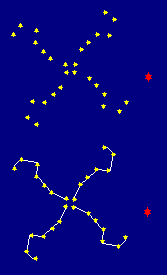
For those of you who have ever wondered where ancient peoples got the idea for the Swastika, I came across the explanation that when the outline of the Big Dipper's "handle" is placed end-to-end to represent the positions of this "constellation" during the two Solstices and two Equinoxes, the image of the Swastika is born. While this idea is quite appealing in and of itself, we should also consider that the arms of the Swastika reflect the numerical quantity of stars in the Big Dipper, which total seven. In other words, if you separate the arms of the Swastika at its base, you have four sevens. The number seven was considered a sacred number at the early stages of humanity's search for answers to life's mysteries. By looking at the stars without the aid of a telescope, seven "wandering stars" were identified by the naked eye: Sun, Moon, Mars, Mercury, Jupiter, Venus, Saturn... which had a considerable influence on the ideas of ancient peoples. A vestige of this seven-as-a- sacred-number view is exemplified in our continued usage of a seven day week. (But let us not forget to mention how sacred the number four has also been in a variety of religious-oriented contexts.) Some people consider that the retention of old ideas such as this keeps humanity in an ancient frame of mind and inhibits our development towards a greater expansion of consciousness. From the Encyclopedia Britannica we find the following
reference to the swastika: The swastika also appeared in early
Christian and Byzantine art (where it  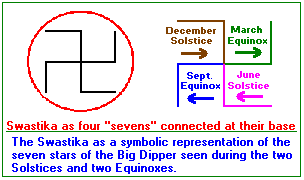 Not only may we want to interpret the presence of four "sevens," but also four "L's," or four "J's." The "L's" and "J's" are also seen in some migrating bird formations. |
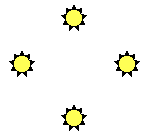 |
Another example of how the Swastika may have arisen to some ancient peoples, is given in the idea that by developing a time keeping/calendar based on the Sun's position during four points of the year, and then tracing out a circle (but not a diamond nor square?) based on the viewed that the Sun moves in an apparent circular fashion, ancient peoples arrived at the foundation for the development of the Swastika as well as the Celtic cross. |
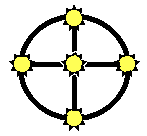 |
 |
Swastika of Ancient Greece (notice subtle "SS" in block letters.) |
 |
Swastika found on the rune stone of Norway |
 |
A form of Swastika used in Christian symbolism |
 |
"Fulfot" form of Swastika from England |
 |
"Tetraskele" form of swastika from Greece |
 |
Left hand spinning "sauvastika" |
 |
Left hand spinning Swastika |
 |
Right hand spinning Swastika |
As a counterpart to the number seven, the number four also was (and in some circumstances still is) considered a sacred number which ancient peoples identified with the Earth because of the notion of four directions. This idea of four directions comes from placing oneself in the center of the world, hence, early people clearly were very self-centered which we of today frequently term as being egocentric. When we adapt a slightly altered version of the generalized notion of Ontogeny recapitulates Phylogeny as proposed by Ernst Haeckel; in that an individual (animal) develops by passing through the (adult) stages of ancestral life forms, the presence of egocentricity in children (and infants) presents some observers with the idea that this is the reason why we find recurrences of ideas and behaviors that were popular centuries ago, in many people of today.
A specific example of this is the idea that the interest in "Heavy Metal" references by some adolescents is a recurrence of an antiquated interest in primitive metallurgy where the idea of "Heavy Metal" was found in medieval swords, suits, etc..., and is the subtly concealed notion exhibited in the "Sword in the Stone" tale of King Arthur, in which the ability of "drawing" the sword out of the stone is a reference to someone having knowledge about metallurgy and smelting raw ore.) Such an example is but one of many that some observers cite as being representative of stages of mental development that many people (and even groups of people pass through developmentally, which are expressed by displaying interests in things of the past such as dragons, dungeons, witchcraft, angels, demons, etc...
In other words, we see periodic resurgences of past, primitive, and primordial themes being played out by individuals, groups, governments, etc... We see such recurrences in clothing, world views, eating interests, laws, architecture, music, science, religion, sports, hair styles, movies, stories, etc... With such recurrences, we might want to consider that humanity simply relives past themes in a variety of combinations. No less, the idea of portraying past behavior is also sometimes offered to explain why criminals are said to be nothing more than reptilian-like "beasts of prey" whose mentality is better suited to some distant past of animal development that humanity experienced in one way or another. Some criminals are considered to be using the hide of a human, in a similar fashion to primitive hunters wearing the hides of game they intend to stalk, as a means of camouflaging themselves in order to better stalk further human prey without detection.
By flip-flopping Ernst Haeckel's idea around, it is the occurrence of egocentricity in children which gives some people the idea that the mental development of humanity as a whole, appears to have once developed (and is still developing in a similar fashion) to that which we observe taking place in the mental development of a single individual. For example, when we notice that infants and children clearly are very self-centered in the sense of being focused on securing their immediate needs, it is considered that early humans thought in terms very similar to infants and children. It's no wonder ancient peoples had so many gods, monsters, and fire breathing dragons,...look at all the goblins, boogey-men, witches, etc., that children of today also imagine.
We must wonder whether ancient peoples were more influenced by the presence of a certain quantity of stars, or by their own (infrequently occurring) concerted agreement of awareness and interpretation of the same event. Surely the fact that a group of people getting together in agreement of an observation is highly influential... Not only to themselves, but to others that esteem them for one reason or another, whether or not the final draft of their observation has any validity beyond their immediate interests. This is easily understood in the persuasive power of those who agree on a treaty, declaration of independence, law, etc...
To take one example, the form of Democracy as it is practiced in the U.S. is not necessarily the form of Democracy that would be best for other people with a different ethnic mix living in a different environment with different quantities and qualities of resources. In fact, it can not be certain to anyone that Democracy is "THE" best form of social self-governance for all of humanity to reach the epitome of health, wealth, and happiness. In order to accept Democracy as one's philosophy of social self-governance, one's brain must be configured in a particular way, and it is not yet agreed upon whether this frame of mind is best for humanity as a species. It is only because of America's wealthy natural resource base that enables it to be presently "persuasive" in getting less self-sufficient countries to adopt its governmental policy views. Take away America's resources, and the face of Democracy may be in the form of a lean, mean, poorly equipped fighting machine. Not only fighting off external threats, but internal ones as well.
And so we ask, when is humanity going to grow up? But what does this mean? If we are still evolving, then there is no "adult" human yet to provide humanity with a role model. Yet humanity has tried to create such an idealized adult to emulate, and have given various names with a variety of qualities to such "Adult Standards" as Jesus, God, Mohammed, Buddha, etc., and to a lesser extent is represented by sports heroes; "Larger than Life" Actors and Actresses; "Mighty" Industrialists; "Intelligent" Scientists; "Gifted" Musicians; "Wise" Philosophers; and various other attributes considered by many people to be desirable and (for one reason or another deemed) necessary.
But talk about the blind leading the blind... In this case, all of humanity is made up of children leading other children, all of whom are trying to act grown-up with a variety of mannerisms relative to different immediate concerns, and yet nobody has the faintest notion of what "Being Grown Up" means in a larger Anthropological, Psychological, Evolutional sensibility of context.
3 viewings of planetary alignment is suggested for the Christmas Star:
Could it have been a planet or a conjunction of planets? Well, interesting theory. If it was a single planet, it could only have been Venus, however, this planet would have been seen periodically, thus not indicating anything spectacular. A conjunction of planets is the most likely theory. Venus passes in front of Jupiter every 247 years, giving us an alignment. The last recorded incident took place in 1818. So it is not due to take place until the year 2065. However this did occur during 2 B.C. So does this indicate the birth of Christ being in fact 2 B.C.? If so this does not tie in with the taxation dates, which was 8 B.C. What about any other planetary conjunction's?
Jupiter and Saturn were found to have had a conjunction in 7 B.C. and this would have also been brighter, hence being the two largest planetary objects in our solar system, and also would have been visible for a longer period. This conjunction would have lasted several months. In fact the two planets would have been seen from the given area, three times in main conjunction, hence being their brightest:
- The first would have occurred on May 22nd 7 B.C.
- The second was seen on October 6th.
- The third rising on the morning of September 15th through December 1st, 7 B.C.
http://maxpages.com/mapit/THE_CHRISTMAS_STAR
3 types of men mentioned in the scriptures (I Cor. 2:14-16 and 3:1-4):
The natural man- is the unregenerate man devoid of spiritual life. He is man without God, under the dominion and control of his five natural senses. He lives completely in the carnal (fleshly) or earthly realm. The senses of sight, smell, sound, taste, and feeling govern his life.
The natural man is completely dead so far as God and righteousness are concerned. His death is the result of the curse of the law that says the soul that sinneth it shall die. He may be a fine citizen, religious, moral and upright, but he is still dead. He doesn't need religion or reformation, he needs life. The life he needs is Christ. This is why he must be born again.
Devoid of spiritual life the natural man has no capacity for the things of the Spirit. If he happens to be religious he is still dead to God and true righteousness. His religion is external with his heart unchanged. In this condition he is incapable of understanding spiritual things. I Cor. 2:14.
The carnal man- has received Christ into his heart but he is still to a great degree under the influence of a fleshly-dominated mind. The five natural senses still influence him greatly despite the fact that Christ has come into his life. In fact he is so influenced and controlled by his fleshly mind until he acts and thinks like the natural man at times.
Being a spiritual babe, the carnal man is limited in his ability to perceive things of the spirit. I Cor. 3:1-3, Heb. 5:12-14. Because of immaturity he is also more subject to the influence of demons than a spiritual man. Strife and divisions are chief characteristics of those living in this realm. The carnal man can be on the mountain top today and in the deepest valley tomorrow. Because of his immaturity he goes by his feelings more than he does the Word.
However, there is a distinct difference in the natural man and the carnal Christian. Whereas the natural man is dead and cannot receive spiritual things at all, the carnal man has life and is capable of receiving and growing in the grace and knowledge of God. I Peter 2:1-2, 2 Peter 3:18, Eph. 4:15, Romans 12:1-2.
The spiritual man- is one who has grown up in spiritual things and is more under the control and influence of the Spirit and Word of God than he is the flesh, his spirituality, of course, depending on the degree of growth and development.
Those who are spiritual have presented their bodies a living sacrifice, holy and acceptable unto God. They have consequently been transformed by the renewing of their minds whereby they are able to know what is that good and perfect and acceptable will of God. Rom. 12:1-2.
It is the renewed mind of the spiritual man that enables him to discern good on one hand and evil on the other. Heb. 5:14. A common ruse or deception that Satan uses on the natural man and the carnal Christian will not work against one that is spiritual. He alone is capable of walking in the Spirit and not fulfilling the lusts of the flesh. Galatians 5:16. The spiritual man alone can say of Satan "...we are not ignorant of his devices." 2 Cor. 2:11.
Links that may be of interest to those interested in the Swastika:
Initially created: Saturday, January 01, 2011
First Posted: Friday, March 28, 2014
Updated posting: Friday, April 4, 2014
Herb O. Buckland
herbobuckland@hotmail.com
 became known as the gammadion cross, or crux gammata, because it
could be constructed from four Greek gammas G attached to a common base), and it occurred
in South and Central America (Among the Maya) and in North America
(principally among the Navajo). The image to the left is but one of
several variations of the gammadion cross, that is also known by other names.
became known as the gammadion cross, or crux gammata, because it
could be constructed from four Greek gammas G attached to a common base), and it occurred
in South and Central America (Among the Maya) and in North America
(principally among the Navajo). The image to the left is but one of
several variations of the gammadion cross, that is also known by other names.